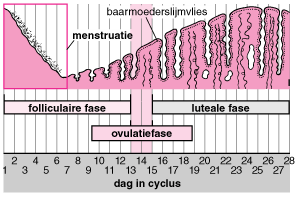Menstruation and ovulation
When you are trying to conceive, it’s useful to know more about your menstrual cycle. To figure out how long your cycle is, start at day 1 of your period, until day 1 of your next period. A cycle is about 28 days on average.

Figuur 1© 2010 Merck & Co, Inc, Whitehouse Station, New Jersey, USA.
The first three to six days are characterized by blood loss (menstruation, or having your period). The womb sheds its lining. In the six to seven days after that, the lining is restored. At the same time, an egg, or ovum, is maturing in the ovaries. When the egg leaves the ovary, that’s the ovulation. This takes place about 14 days before you will get your period again. This period is your fertile period. During this time, your uterine lining will be prepared so a fertilized egg can attach itself. If there is no fertilization, the uterus will shed the lining again after 14 days and the cycle will start anew.
The duration of the cycle is determined by the first phase (follicular phase). The third phase of the cycle, the luteal phase, almost always lasts 14 days. You can determine the time of your ovulation afterwards by counting fourteen days from your first menstruation day.
A 28-day cycle occurs only in 15% of women. Most women have a cycle between 21 and 35 days. This is considered normal. Even if you have a longer or shorter cycle, the ovulation often occurs 14 days before the next expected period. Women with a shorter or longer cycle often have a little more difficulty in conceiving because there is a larger chance that no ovulation will take place.
If you have irregular periods or if your cycle is shorter than 21 days, or longer than 35? Or do you have any other questions about menstruation? You’re very welcome at our conception consultation hour.


